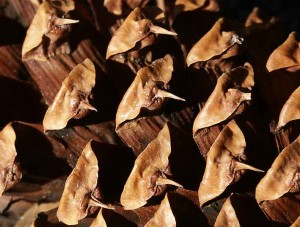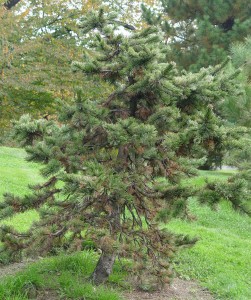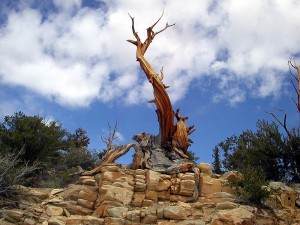A Bristlecone Pine Named ‘Methuselah’
Posted in Around the Garden, Gardens and Collections on December 19 2011, by Joyce Newman

The oldest living tree currently known on the planet–a Bristlecone Pine named “Methuselah”–is located high in the White Mountains of eastern California. It is estimated to be about 4,700 years old, as old as the great pyramids in Egypt and older than Hammurabi, the Babylonian king. To protect the tree, its exact location has been kept a secret.
Scientists say that other, even older bristlecones (Pinus longaeva) exist, but simply haven’t been dated yet. As you have probably guessed, the species gets its common name from its scaled cones, which have spiny, claw-like bristles sticking out from each scale.
In the Arthur and Janet Ross Conifer Collection at the NYBG, a young Bristlecone Pine grows on the hillside north of the Enid A. Haupt Conservatory. This specimen is actually a different bristlecone species, Pinus aristata, but it has similar long-life genes to those found in California’s Pinus longaeva.

“Methuselah” was discovered by Dr. Edmund Schulman in 1957 and has been called “the tree that rewrote history” because it has provided wood (both dead and living) with a tree ring chronology spanning thousands of years. The data from these tree rings has helped scientists more accurately calibrate the carbon-14 dating technique, and in turn supports other crucial scientific research across many fields.
Dr. Schulman was a student of Dr. A.E. Douglas, who is known as the father of modern dendrochronology, the science of tree ring dating. The term comes from two Greek words: dendron (tree) and chronos (time).
People have known that each tree ring represents one year of growth for many years. But in the 1920s, Dr. Douglas discovered something else about the rings: environmental conditions (temperature, rainfall, sunlight) could influence the width of the rings. Not only that, but patterns of wide and narrow rings could also be compared from tree to tree within the same species. Comparing younger trees to older ones, Dr. Douglas found he could build a timeline of growth ring patterns reaching back hundreds, even thousands of years.
While examining Methuselah–it’s about 10,000 feet up in the mountains–scientists took core samples using a special drill. They found a strange pattern: a series of very narrow rings. Scientists think that the rings are evidence of volcanic eruptions nearly 3,600 years ago. The eruptions filled the atmosphere with ash and soot, enough to block the amount of sunlight reaching Earth. Consequently, temperatures fell, and so the Bristlecone Pine grew very slowly.

Many of the earth’s major natural events–forest fires, century-long droughts, plagues of insects, and glacial freezes–are “recorded” by tree rings in the world’s oldest trees.
In one notable case, U.S. dendrochronologists studied one of the world’s most famous and controversial violins, the “Messiah,” rumored to have been produced by Italian luthier Antonio Stradivari (valued at up to $20 million). They found that it was, in fact, crafted during Stradivari’s lifetime by dating the Norway spruce it was made from.
As a piece of living history, “Methuselah” remains one of the most important discoveries in botany. You can learn more about tree-ring dating from the Laboratory of Tree-Ring Research at the University of Arizona, which was founded by Dr. Douglas.


This is an amazing piece…how fantastic to explore time and history through trees. Hoping they’ll be a “Tree Tour” at NYBG someday, that might make a nice option. Thank you for this info!